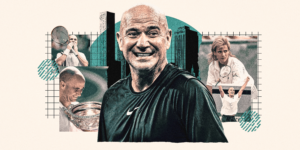Scholars of antiquity believe they are on the brink of a new era of understanding after researchers armed with artificial intelligence read the hidden text of a charred scroll buried when Mount Vesuvius erupted nearly 2,000 years ago.
Hundreds of papyrus scrolls kept in the library of a luxurious Roman villa in Herculaneum were burned when the town was devastated by the intense blast of heat, ash and pumice that destroyed nearby Pompeii in AD 79.
Excavations in the 18th century recovered more than 1,000 whole or partial scrolls from the mansion, believed to have belonged to Julius Caesar’s father-in-law, but the black ink was illegible on the charred papyrus and the scrolls crumbled to pieces when researchers tried to open them.
The breakthrough in reading the old material came from the $1 million Vesuvius Challenge, a competition launched in 2023 by Brent Seales, a computer scientist at the University of Kentucky, and Silicon Valley supporters. The competition offered prizes for extracting text from high-resolution CT scans of a scroll taken at Diamond, the UK’s national synchrotron facility in Oxfordshire.
Nat Friedman, an American technology executive and founding sponsor of the challenge, announced on Monday that a team of three computer-savvy students, Youssef Nader in Germany, Luke Farritor in the US, and Julian Schilliger in Switzerland, had won the $700,000 ( £554 000) grand prize after reading more than 2,000 Greek letters from the scroll.
Papyrologists who studied the text recovered from the black scroll were amazed at the feat. “It’s a complete game changer,” said Robert Fowler, emeritus professor of Greek at the University of Bristol and chairman of the Herculaneum Society. “There are hundreds of these scrolls waiting to be read.”
Dr Federica Nicolardi, a papyrologist at the University of Naples Federico II, added: “This is the beginning of a revolution in Herculaneum papyrology and in Greek philosophy in general. It is the only library dating from ancient Roman times came to us.”
“We’re moving into a new era,” said Seales, who led efforts to read the scrolls by virtually unpacking the CT images and training AI algorithms to detect the presence of ink. He now wants to build a portable CT scanner to image scrolls without moving them from their collections.
In October, Farritor won the challenge’s $40,000 “first letters” prize when he identified the ancient Greek word for “purple”, in the scroll. He teamed up with Nader in November, with Schilliger, who developed an algorithm to automatically unwrap CT images, joining them days before the game’s Dec. 31 deadline. Together, they read more than 2,000 letters from the scroll, giving scholars their first real insight into its contents.
“It’s been an incredibly rewarding journey,” Youssef said. “The adrenaline rush is what kept us going. It was insane. This meant working 20-something hours a day. I didn’t know when one day ended and the next began.”
“It is probably Philodemus,” Fowler said of the author. “The style is very gruff, typical of him, and the subject is on his way.” The scroll discusses sources of pleasure, touching on music and food – especially capers – and whether the pleasure experienced from a combination of elements is due to the major or minor ingredients, the abundant or the frightful. “In the case of food, we do not immediately believe that things that are scarce are absolutely more pleasant than those that are abundant,” writes the author.
“I think he is asking the question: what is the source of pleasure in a mixture of things? Is it the dominant element, is it the rare element, or is it the mixture itself?” Fowler said. The author ends with a parting shot against his philosophical opponents because he has “nothing to say about pleasure, either in general or in particular”.
Seales and his research team spent years developing algorithms to digitally unroll the scrolls and detect the presence of ink from the changes it produced in the papyrus fibers. He released the algorithms for participants to build on in the challenge.
Friedman’s involvement was valuable, not only in attracting financial donors. When Seales was meant to fly to the United Kingdom to have a scroll scanned, a storm blew in to cancel all commercial flights. Concerned that they might lose their slot at the Diamond Light Source, Friedman hastily organized a private jet for the trip.
Besides the hundreds of Herculaneum scrolls waiting to be read, many more may be buried at the villa, adding weight to arguments for fresh excavations. The same technology could be applied to papyrus wrapped around Egyptian mummies, Fowler said. These can include everything from letters and property deeds to laundry lists and tax receipts, shedding light on the lives of ordinary ancient Egyptians. “There are crates of this stuff in the back rooms of museums,” Fowler said.
The challenge continues this year with the goal of reading 85% of the scroll and laying the foundation for reading all that has already been excavated. Scientists need to fully automate the process of tracing the surface of the papyrus within each scroll and improve ink detection on the most damaged parts.
“When we launched it less than a year ago, I honestly wasn’t sure it would work,” Friedman said. “You know, people say money can’t buy happiness, but they have no imagination. It was pure joy. It’s magic that happened, it couldn’t have been written any better.”






